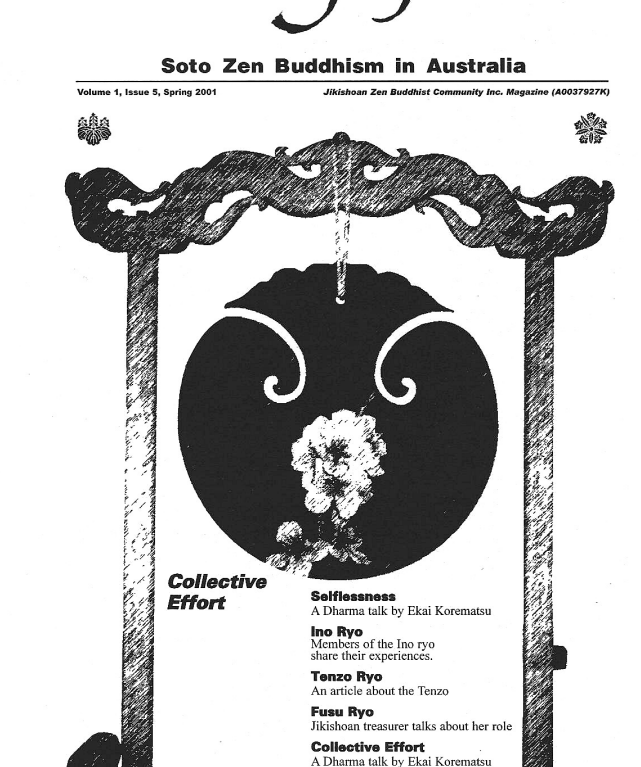Editorial
“The mystery is
that it is possible for us to do
what we don’t not know how to do”
Welcome to the spring edition of Myoju, the magazine of the Jikishoan Zen Buddhist Community in Melbourne, Australia. Given that it is spring, the theme of this edition is the new growth, which comes from combined or collective effort.
Over the last three years or so Jikishoan has grown in size. The successful running of Jikishoan’s activities, Sunday Sanzen-kai retreats, magazines, finances and membership, has required more and more organisation. This edition looks at the new growth within Jikishoan – the ryo groupings that carry out all of these tasks. Its aim is to highlight the value of collective effort, as a complement to the individual effort we make when seated on our zafu.
Ekai describes the practice as a ‘body based practice’ which ‘gives us experience through action’. Working as part of a ryo provides a wonderful opportunity to live out the practice dynamically, to learn to just do rather than to over-think things, and to reduce the separation between the practice and ‘ordinary life’. Integrating the practice with everyday living is an ongoing task. Transferring the sense of balance and centredness that can arise from sitting to dealing with problems such as burning the toast, missing the train, dealing with customers and colleagues and so on can be difficult. In the Dharma talk entitled ‘Selflessness’, Ekai points out the centrality of selflessness to all Buddhist teaching and practice. He says that ‘selflessness manifests when you forget about your body and just act’ (p.6). Ringing the various bells as part of the Ino ryo has taught me the truth of this- they are a great indication of self-consciousness. Things go best when there is just bell ringing, not ‘Gary ringing the bell’.
Cooking as part of the Tenzo ryo, or timing the round in the zendo as part of the Ino ryo provides an opportunity for us to work with others. Biggi writes that ‘ryo practice for me has been practice in relationship to others’ (p.7). Hannah realised that her role as a Tenzo wasn’t about food, ‘it was about dealing with people’ (p.9). Julie comments that ryo practice is ‘about people practicing as individuals and practicing as a sangha at the same time…if we lose sight of one or the other then we find ourselves getting stressed needlessly’ (p.13) Working as part of a ryo group allows us to integrate the practice into everyday activities. It complements the more passive activity of sitting and as such provides a balance.
In the Dharma talk ‘Collective Effort’ (p.14) Ekai points out the importance of practicing together. He says that rather than getting ‘spaced out’ when sitting, ‘thanks to the…helping power of practice communities…our feet are still on the ground and the ground is a very solid ground based on reality’.
Thank you to all who have contributed ideas, articles and artwork to this edition of Myoju. This publication is the result of the work and contributions of many, many people- it is an example of the collective and active aspect of the practice. Thank you in particular to Georgia and Leesa for their proofreading and suggestions, and to Karen for her tireless work in design layout. And as always, thank you to Ekai for sharing this practice.
Gary Youston

